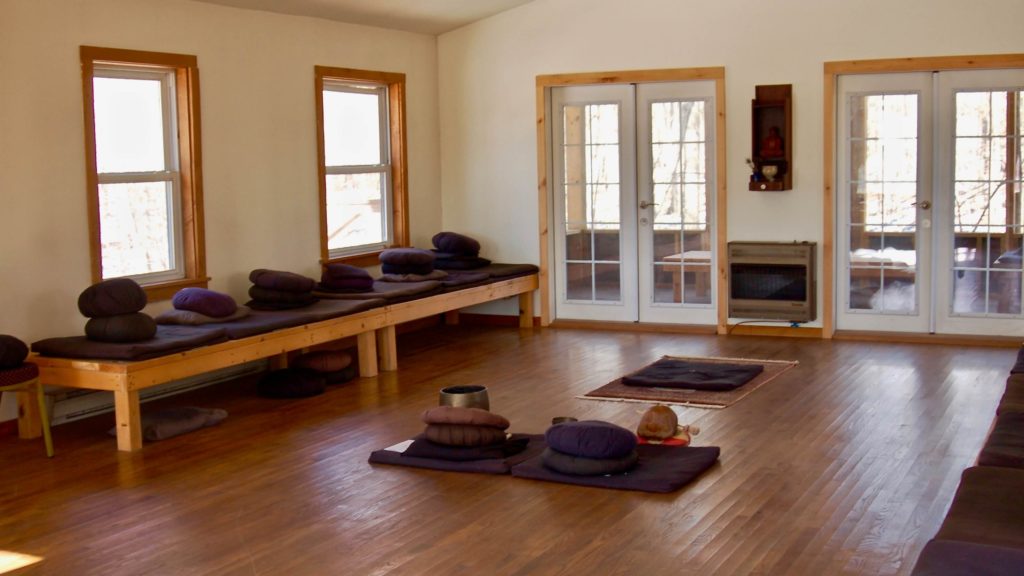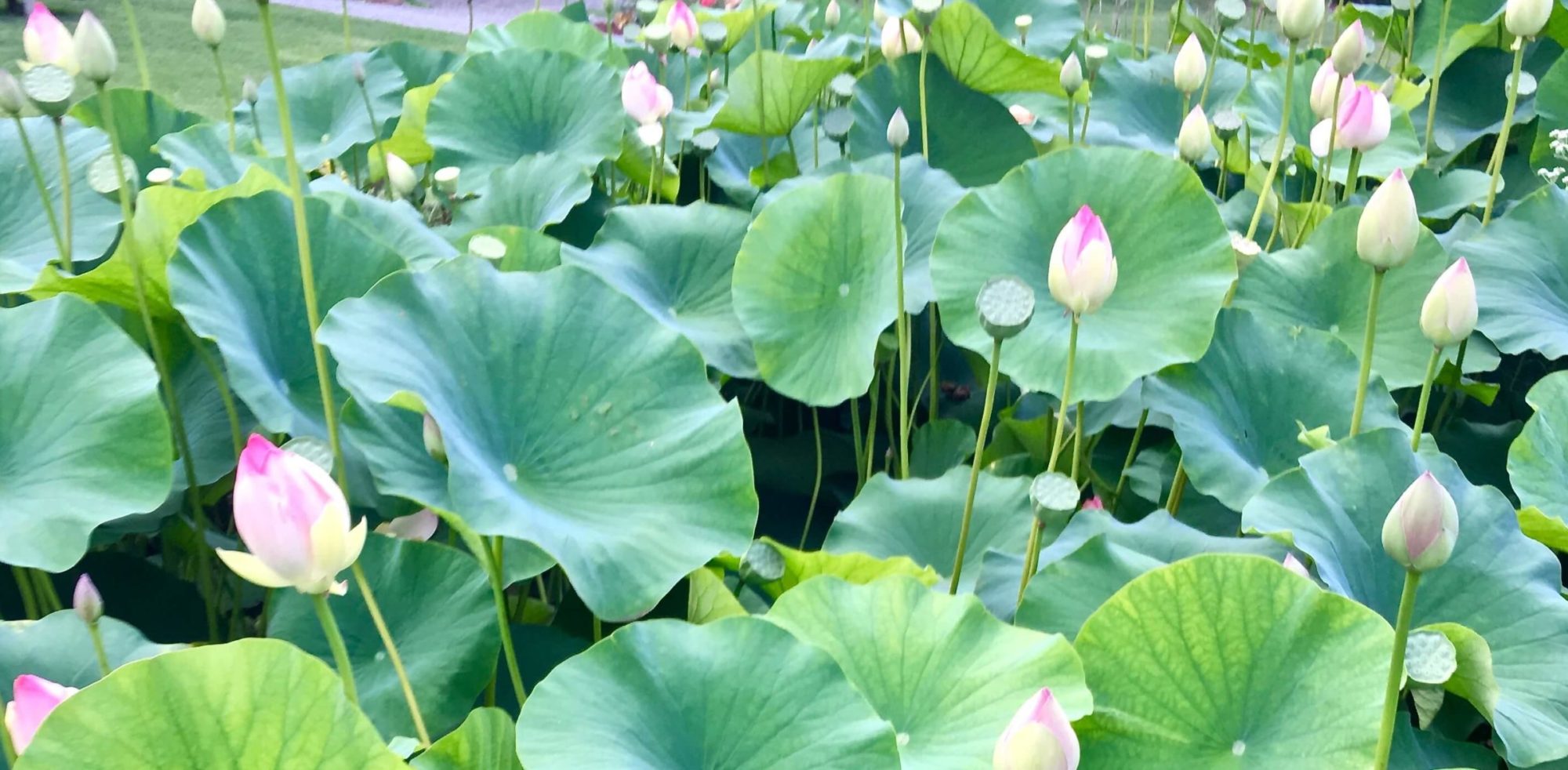
Etiquette for the meditation hall
This guide is designed to assist newcomers with the customs of the Ithaca Zen Center meditation hall. In our zendo, practicing together means taking up a common set of forms to express the harmony of the practitioners and to provide a means to focus and let go of thinking. By surrendering to these forms you can direct your energy toward observing what is, rather than thinking about what to do. We create an external environment that supports and reflects our internal practice of awareness and self-surrender.
Entering the zendo
Leave shoes on the porch. After entering the meditation hall, bow in the direction of the altar. Walk with hands in the palms together position (gassho) to any seat except at the four corners. Bow away from the cushions and take your seat.
When arriving at the zendo after a sitting period has already begun, bow at the entryway to the zendo, take one step into the zendo and bow to the shoji (the shoji is always seated closest to the entryway). If the shoji returns the bow, continue to your seat with hands in gassho, bow and sit down.
Zazen
Arrange the cushions so that you can sit comfortably with a straight back without moving for the duration of a sitting period (20 to 30 minutes). The knees may be folded back in the seiza position (sitting on the shins and knees), or crossed in front as in the Burmese, half lotus, or full lotus positions. The hips should be rolled slightly forward and the spine fully lengthened. The chin should descend slightly, keeping the back of the neck long. Pulling down the shoulder blades will open the chest for more comfortable breathing. Eyes should be kept slightly open to allow the meditative mood to pervade the natural waking state. Hands should make an oval, left hand on top, thumbs touching lightly. Thumbs should be at approximately navel height. Breathing should be relaxed and very slightly extended in the exhalation. Allow awareness to pervade the breathing. The mind should be observed but not followed (e.g. as in daydreaming, getting lost in thought, or working out problems). If you cannot sit comfortably on the cushions without moving for the length of a sitting period, please sit in a chair or on the edge of the bench chair style.
Receiving tea
After the jiki rings the bell to accept the shoji’s clap for tea service, the teacup is picked up and held in the palms in zazen position. When the shoji serves tea, present the teacup with one hand and turn the empty hand palm up next to it. If two people are sitting in adjacent seats, move the teacups together to facilitate service. Raise the empty palm to indicate when you have enough tea. Tea must be taken the first time. Keep the teacup in your hands until tea is offered a second time. Raise your cup to ask for more tea or bow from the waist to decline the second offering of tea. Wait until the person next to you is served before starting to drink. Use two hands to drink your tea. When serving tea, the shoji will bow to the first and last person on a bench and they will return the shoji’s bow. When finished, put your teacup behind you on the bench.
Chanting and bowing
Chanting should be done in a full voice. Chant books are located between the pillows and the wooden benches under each seat, and are also available here. Hold the book up so that the basic zazen position can be maintained. At the end of chanting, a roll of bells will ring. Stand with hands in gassho. At the sound of the bell, make a full bow—first bowing from the waist, then bowing to the floor, kneeling with the forehead on the ground and palms turned up alongside the head. Raise up the palms. When the bell is muffled, return to standing position with hands in gassho. There are three full bows after chanting. After the three bows, the jiki will ring the bell; bow with hands in gassho. Wait for the clappers to sound. (One clap indicates that a period of walking meditation is about to begin and two claps signals a brief resting period followed by sitting.)
The first sutra chanted is the heart sutra, a very concise exposition on the nature of emptiness. it is the most commonly chanted sutra in the zen tradition. The second chant is an english translation of the heart sutra. The third chant is a dharani, not necessarily translatable. Dharanis are invocations of energy. The fourth chant is the dharani of the compassionate one. Brief ekos or honorary chants, follow the third and fourth chants. The first is an expression of gratitude to the buddhas, bodhisattvas and the great transcendental wisdom. The second expresses gratitude to the main figures in the lineage of our roshi. The fifth chant is the sermon of Kozen Daito on his deathbed to the members of his monastery. Kozen Daito was born in the 13th century, and his student founded Myoshin-ji temple, the head temple of roshi’s lineage. The sixth chant is a translation of the fifth. The final chant is the four great bodhisattva vows which can be seen as a natural expression of the wisdom view or the commitment of an aspirant to that view.
Walking meditation
The jiki begins the walking meditation (kinhin) by ringing the bell and hitting the clappers one time. At that time, bow from the waist with hands in gassho and stand with hands in gassho. When the clappers strike again, bow from the waist and place your hands over the solar plexus, left hand over right, right thumb over left, and forearms parallel to the ground (sassho). Walk in line out of the zendo, put on shoes, and reassemble in a line behind the jiki in the same order as leaving the zendo. To bow out of line (to go to the bathroom, etc.), step outside the line and bow. When returning to the walking line, bow in and re-enter in the same position as before. When returning to the meditation hall, the jiki will hit the clappers once. At this time, hands should return to the gassho position. When entering the zendo, only the jiki bows; the rest should walk with hands in gassho back to their seats and stand. When the jiki rings the bell, bow, sit and resume zazen.
Rest period
After ending a meditation period with a ring of the bell, the jiki may hit the clappers twice. This signifies a rest period—usually 5 minutes. Everyone planning to rest should bow. Those remaining seated in zazen do not need to move. There are two ways to rest: sitting chair style at the edge of the bench with the hands in the zazen position, or standing in front of the platform with the hands over the solar plexus in the sassho position as during walking meditation. Do not change positions in the middle of the period. At the end of the rest period, the jiki will hit the clappers once. Stand in with hands in gassho (unless you have remained in the zazen position). Bow at the sound of the bell and return to the zazen position.
Leaving the zendo
The jiki will ring the bell once, rise and bow at the altar. Remain still while the jiki bows. The jiki will then walk to the back of the zendo and bow. Bow at your seat with the jiki then stand up and straighten the cushions, bow again and leave. If you must leave the zendo at another time, try to wait for the end of a sitting period. If this isn’t possible and you must leave during a sitting period, bow at your seat, stand with hands in gassho and bow in front of your seat, walk to the back of the zendo with hands in gassho, bow to the shoji and leave.
